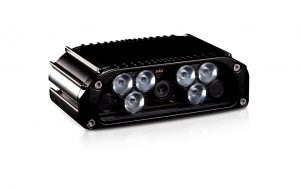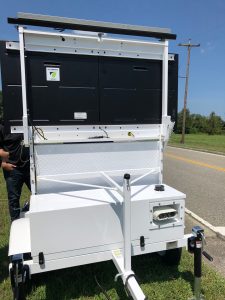Automated license plate recognition (ALPR) systems were introduced during the 1970s as a way for officers to innovate their data collection process. Prior to the use of license plate recognition technology, law enforcement professionals would have to manually call a plate through the in-car computer or radio into the central dispatch. The ALPR solution expedited the extensive process, allowing officers to focus on other tasks.
Although it would benefit the investigative process, the technology did not gain momentum within the field until the late 1990s and early 2000s when the software became more attainable and efficient.1
By 2007, almost half of the largest law enforcement agencies were regularly using ALPR solutions, along with nearly one-third of agencies with 500–1,000 sworn officers.2
Today, an even larger number of agencies—small and large—are using ALPR units due to the low-cost, effective options that many companies now offer. As more agencies have become familiar with this solution, officers are looking to include the revolutionized technology in their day-to-day work.
Fixed, Stationary ALPR Units
The initial version of an ALPR system came in the form of a fixed unit. Stationary ALPR units are a useful tool for real-time crime centers to improve operational efficiencies, as well as for investigators who are searching for plates within a specified area.
One provider offering a fixed camera ALPR software solution is the Greensboro, North Carolina–based Leonardo Company. Through the ELSAG ALPR product portfolio, Leonardo has introduced the ELSAG VPH900, which enables users to get the benefits of ALPR technology using off-the-shelf standard IP cameras.3
“The ELSAG VPH900 is an advanced technology that reduces the cost and hardware associated with including license plate recognition in perimeter security and access control solutions,” said Julio Valcarcel, Leonardo’s vice president of sales. “We can now configure customers’ existing IP cameras with the VPH900 solution for identifying and monitoring vehicles.”4
The ELSAG VPH900 solution allows users to capture vehicle information efficiently to collect usable data without the use of infrared cameras. In environments where traditional LPR cameras would not be feasible due to cost and infrared-use limitations, this software solution can be used in conjunction with existing hardware, provided the cameras meet limited criteria.
As a camera records passing vehicles, the ELSAG VPH900 software pulls data for each vehicle, such as license plate number, date and time stamps, and the identification of the camera capturing the video. These data are compared against lists to identify suspect vehicles or validate permitted ones. After review, the images and data are stored for future access and analysis to aid investigations.
When paired with the ELSAG CarSystem or Enterprise Operations Center software, the VPH900 can generate real-time alarms when suspect vehicles are identified.
Also providing fixed ALPR units is Genetec, Inc. Based in Montreal, Canada, Genetec provides purpose-built specialized technology with a focus on IP-based security solutions.5
 The Genetec AutoVu ALPR system automates license plate reading and identification, making it easier for law enforcement to locate vehicles of interest. Because the system sends notifications to approved users and surrounding officers, it can help to reduce the time needed to solve a crime or prevent a threat to the public.
The Genetec AutoVu ALPR system automates license plate reading and identification, making it easier for law enforcement to locate vehicles of interest. Because the system sends notifications to approved users and surrounding officers, it can help to reduce the time needed to solve a crime or prevent a threat to the public.
Using optical character recognition, the collected data allow officers to read and capture images of plates to help determine whether a vehicle was used in a crime. Metadata such as GPS location, date, and time are included with the images.
The AutoVu’s fixed camera, AutoVu SharpV, can be mounted on a pole, building, or gantry. The all-in-one ALPR device combines two high-definition cameras with onboard processing and illumination in a rugged, environmentally sealed unit.
Mobile ALPR Units
In addition to provided fixed solutions, companies are research-ing effective ways to implement and provide mobile ALPR technology. Mobile units offer most (if not all) of the same benefits of fixed units, with the added capability of being moved to different locations.
Not only does Genetec offer its ALPR system as a fixed unit, but it also includes a mobile component. “The SharpZ3 goes beyond traditional plate identification and brings new levels of insight in vehicle analytics, situational awareness, and accuracy,” said Director of AutoVu Sales Larry Legere.
Genetec’s AutoVu SharpZ3 is a mobile system that is traditionally mounted atop a vehicle. It improves the accuracy of reads in difficult environments such as bad weather, heavy traffic, and fast speeds, while also recording additional vehicle characteristics without requiring large amounts of bandwidth.
Designed with a third optical sensor, the device can accurately capture multiple plate designs in complex urban environments. This includes flat, embossed, reflective, and non-reflective plate designs. The third sensor precisely positions objects and vehicles to better understand what is around the license plate.
 Stemming from customers’ demands for a highly mobile ALPR solution that doesn’t attract the attention of drivers, the Herndon, Virginia-based All Traffic Solutions created a mobile “ALPR-ready” trailer designed for law enforcement flexibility and durability.
Stemming from customers’ demands for a highly mobile ALPR solution that doesn’t attract the attention of drivers, the Herndon, Virginia-based All Traffic Solutions created a mobile “ALPR-ready” trailer designed for law enforcement flexibility and durability.
The ATS 5 speed and message trailers double as a sign trailer, as well as a battery and Internet connection platform for an ALPR camera. The trailers can be deployed with ALPR alone or with an All Traffic Solutions radar message sign, radar speed display, or variable message sign. The high-resolution ALPR and varifocal cameras used allow for the reading distance and magnification to be adjusted on-site, reducing system design and specification effort.
According to Andy Souders, president and CEO of All Traffic Solutions, “Having ALPR encased inside a mobile trailer gives law enforcement more flexibility because they can deploy ALPR wherever and whenever they need it, before moving to the next location.”6
The portable sign trailers are easy to maneuver without a truck, enabling officers to use radar speed or message displays wherever needed. The IP67-rated enclosure allows for operation in extreme weather conditions and harsh environments. It also features recessed taillights, DOT-approved lighting, and red-and-white reflective tape.7
Improvements since the creation of ALPR solutions continue to give law enforcement agencies significant advantages in identifying suspect vehicles throughout the investigative process. Whether offered as hardware or software, fixed or mobile, ALPR systems continue to speed up the identification process.
With more familiarity of the technology, officers are noticing these advantages, as well as discovering new ways to use the products. Vendors are responding to these innovative and expanded uses too, offering agencies the products they need to better serve their communities.d
Notes:
1 Andrew D. Dasher, “Three Novel Ways to Use ALPR: Leveraging License Plate Readers for Crime Prevention and Solvability,” Police Chief 87, no. 3 (March 2020): 40–44.
2 David J. Roberts and Meghann Casanova, Automated License Plate Recognition (ALPR) Use by Law Enforcement: Policy and Operational Guide (Alexandria, VA: IACP Technology Center, August 2012).
3 Nathan M. Maloney (vice president of marketing and communications, Leonardo) email interview, April 2, 2020.
4 Julio Valcarcel (vice president of sales, Leonardo) email interview, April 2, 2020.
5 Larry Legere (director of AutoVu sales, Genetec Inc.) email interview, March 25, 2020.
6 Andy Souders (president/CEO, All Traffic Solutions) email interview, April 7, 2020.
7 All Traffic Solutions, “Automatic License Plate Recognition System.”
|
Source List |
|
|
Government Leasing Law Enforcement, LLC
|
LexisNexis Risk Solutions (LexisNexis Coplogic Solutions)
|


